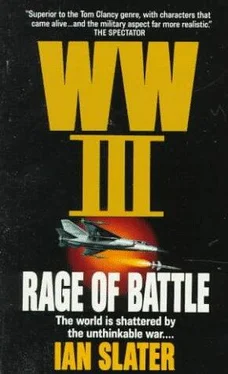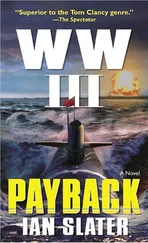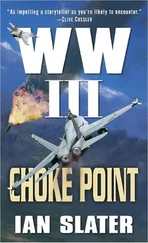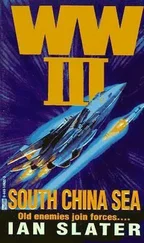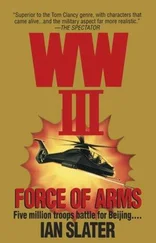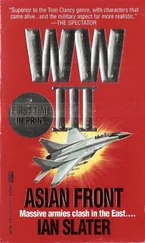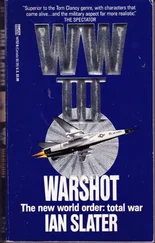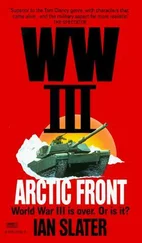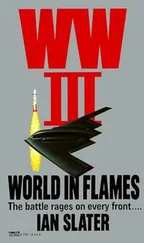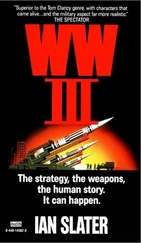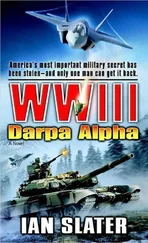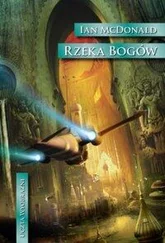Ian Slater - Rage of Battle
Здесь есть возможность читать онлайн «Ian Slater - Rage of Battle» весь текст электронной книги совершенно бесплатно (целиком полную версию без сокращений). В некоторых случаях можно слушать аудио, скачать через торрент в формате fb2 и присутствует краткое содержание. Год выпуска: 1991, ISBN: 1991, Издательство: Ballantine Books, Жанр: Триллер, на английском языке. Описание произведения, (предисловие) а так же отзывы посетителей доступны на портале библиотеки ЛибКат.
- Название:Rage of Battle
- Автор:
- Издательство:Ballantine Books
- Жанр:
- Год:1991
- ISBN:0-345-46514-8
- Рейтинг книги:3 / 5. Голосов: 1
-
Избранное:Добавить в избранное
- Отзывы:
-
Ваша оценка:
- 60
- 1
- 2
- 3
- 4
- 5
Rage of Battle: краткое содержание, описание и аннотация
Предлагаем к чтению аннотацию, описание, краткое содержание или предисловие (зависит от того, что написал сам автор книги «Rage of Battle»). Если вы не нашли необходимую информацию о книге — напишите в комментариях, мы постараемся отыскать её.
Rage of Battle — читать онлайн бесплатно полную книгу (весь текст) целиком
Ниже представлен текст книги, разбитый по страницам. Система сохранения места последней прочитанной страницы, позволяет с удобством читать онлайн бесплатно книгу «Rage of Battle», без необходимости каждый раз заново искать на чём Вы остановились. Поставьте закладку, и сможете в любой момент перейти на страницу, на которой закончили чтение.
Интервал:
Закладка:
In the first twenty-four hours following the Soviet break-through to a megaphone-shaped two-hundred-square-mile area west of Fulda, there were over seventeen thousand civilian casualties, most of these women and children. In the raging cacophony of the battle, involving five thousand NATO and Soviet tanks, the inability of NATO Medevac choppers to get through the dust, smoke, and cross fire meant that many wounded civilians and combatants perished who would otherwise have survived had they been treated at MASH units within the first two critical hours of having been hit. This was particularly the case among the elderly, many of them disoriented — some gone mad from the sight and smells of bodies blown apart and from the ear-shattering screams of shellfire and the gut-punching sound of earth exploding all about them. Utterly confused in the tumult of the highly mobile battle, positions of friend and foe shifting rapidly from one moment to the next, and dazed by indiscriminate artillery and mortar fire, some of the elderly were separated from loved ones, and wandered about, dazed, blinded by dust and smoke, suffocating in gasoline-drenched air and then crunched beneath the advancing Soviet and defending NATO tanks.
The breaching of the gap by the Russian army divisions had come much faster than expected, not only because bad weather over the Polish plain hampered Allied air attacks, but because of a single piece of equipment, vastly underestimated by the Allies.
As reports came through to Allied HQ in Brussels, it quickly became evident that the T-90s, having been fitted with thermal imagers of a quality underestimated by NATO intelligence, had created havoc during nighttime battles. In addition to mixtures of expensive laser and Stad R stereo coincidence and optical range finders, neither of which was proving as good in actual battle conditions as in maneuvers, when the cost of real shells had precluded thorough testing, the Russian T-90s and T-80s had a thermal sight. Originally made under contract in South Korea, and later copied in East Germany, it proved remarkably resilient, whereas the other, more sophisticated, laser imagers used by NATO had run into unexpected trouble after the sustained shock of actual combat.
Although Maj. Kiril Marchenko had played only a relatively minor role in advocating the thermal sight, he nevertheless managed to take a lion’s share of the credit. And it was true that the purchase of the much less expensive thermal imagers did fit with his advocacy of the svyatye dvoyniki — “holy twins” of the Soviet High Command. The first tenet was that overwhelming numbers in the Soviet armies would have to make up for qualitative superiority in the West. And secondly, this meant you had to win quickly — before NATO could rally and/or resupply.
In turn, a quick war meant that not only must sabotage be ruthlessly stamped out in the republics, as General Brodsky in Tallinn had finally realized, but armored columns had to be trained to fight as well at night as in the daylight. Accordingly, at Marchenko’s urging — a very unpopular move at the time — T-90 and T-80 tank regiments had been trained on the vast Russian steppes first at night, then in daylight maneuvers. Indeed, the division of 270 tanks in which Marchenko’s son, Sergei, had fought before winning his transfer to the air force academy and his posting to the Far East station had itself trained first at night. And during these night maneuvers, commanders insisted on tanks maintaining the Soviets’ punishing twenty-five-meter margin between each tank, a much narrower one than that used by the German Leopards, American M-1s, or British Challengers, who disdained such distances for fear of attracting high-density antitank artillery fire.
One advantage the NATO tanks did possess was a gun depression of nine and ten degrees, twice that of the Russian tanks, so that whenever NATO armor was given the chance to withdraw to defensive, hunkered down defilade firing positions, they exacted a deadly price for any S-WP advance. Still, the sheer numbers of the Russian tanks that had poured through the Fulda Gap, a ratio of four to one, had overwhelmed and continued to overwhelm NATO. And this despite the carnage visited upon the massed Russian armor by the high-tail-engined American Thunderbolts. Once thousands of tanks were joined in close battle, often at ranges of less than a thousand yards, the deadly hail of the American Thunderbolts’ armor-piercing twenty-millimeter cannon fire was lost, for in the confusion of night battles particularly, where a T-90 and an M-l became indistinguishable on the pilot’s infrared, NATO’s air superiority in ground attack aircraft ceased to count.
Out of the melee a report, initially lost or simply disregarded in the avalanche of incoming signals, reached an Allied intelligence officer in Heidelberg. It would forever change the nature of war, and strike down the prejudice of renowned tank commanders like Gen. Douglas Freeman.
Recovered from his hospitalization and riding high on his Korean exploits, Freeman, over the objections of most of the Joint Chiefs of Staff, had been ordered by the president to take over command of the Dortmund-Bielefeld pocket. Freeman, known to even the European troops as “George C. Scott” after his successful attack on what he called the “verminous pad of the runt”—Kim Il Sung’s Pyongyang — had stunned his officers during the Pyongyang raid by using women volunteer chopper pilots in the lead assault on the North Korean capital.
At a time when American-ROK morale was rock-bottom in Korea, Freeman had paradoxically reversed his previous stand against using women in combat roles. He had asked for women volunteers to pilot the lead choppers — and had got them. In one stroke he had ended debate in America about women in combat and shamed reluctant male conscripts to “volunteer.” Even so, a prejudice Freeman held close to his bosom and took to Europe was his belief that no matter how successful women might be as chopper pilots or superb ground crew, there was no place for them in a tank. The Dutch Forty-Second Mechanized regiment now trapped in the Dortmund-Bielefeld pocket had been the first to raise the matter. Freeman’s objection, in a confidential memo to the Pentagon, was now part of the growing Freeman legend.
“A tank battle,” he had written, “is no place for a woman. Forty sixty-pound rounds may have to be hand-fed into the main gun if automatic load malfunctions. I do not subscribe to the common theory that a woman aboard a tank will make the men softer — cause the men to be more concerned with protecting the weaker sex than with killing enemy tanks. Nor do I believe they are the weaker sex in terms of their ability to sustain high-level stress. On occasion I would argue they are superior in this regard. Nevertheless, a woman aboard a tank is unacceptable because it is a matter of hygiene. No one in the Pentagon seems to realize that in battle, a tank crew cannot make rest stops. For a tank to stop in the kind of sustained and highly mobile battles we have been engaged in to date would make the tank a stationary target, and as we have discovered with the Russian night sights, the enemy needs only a five-second fix on a stationary target to blow it to pieces. Besides which, the interior of the tank is a highly charged, fume-laden atmosphere in which the necessary body functions only add to an already unpleasant situation. In short, defecation and urination will in most cases have to be undertaken, as they have traditionally been, in helmets until the opportunity for jettisoning such material presents itself— which may not be for many hours. It is not only the severe discomfort and unpleasant atmosphere which I have in mind in strenuously arguing against women tank crews but rather a sensitivity to their need for privacy, which simply cannot be accommodated aboard an armored fighting vehicle.”
Читать дальшеИнтервал:
Закладка:
Похожие книги на «Rage of Battle»
Представляем Вашему вниманию похожие книги на «Rage of Battle» списком для выбора. Мы отобрали схожую по названию и смыслу литературу в надежде предоставить читателям больше вариантов отыскать новые, интересные, ещё непрочитанные произведения.
Обсуждение, отзывы о книге «Rage of Battle» и просто собственные мнения читателей. Оставьте ваши комментарии, напишите, что Вы думаете о произведении, его смысле или главных героях. Укажите что конкретно понравилось, а что нет, и почему Вы так считаете.
